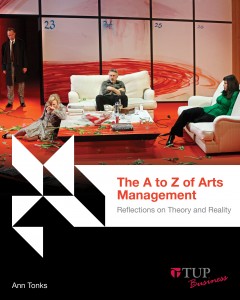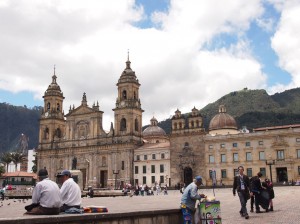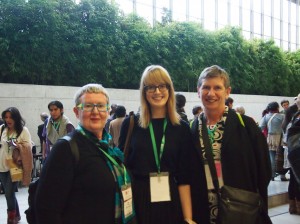There are lots of topics beginning with C for an Arts Management book. My choices were: CEO, Co-leadership, Communication, Conflict, Control, Creativity, Crisis, Cultural Leadership & Cultural Policy. The most quirky topic (and probably one that only some who lives in Melbourne, the coffee capital of Australia could write) is entitled Coffee:
“I can say with some certainly that ‘coffee” (or your social beverage of choice) will not be in the index of any management textbooks. But it should be because our job is about relationships and there is research to show that when people hold a warm beverage, they tend to feel closer to the person with whom they are conversing (Moss, Callanan & Wilson 2012, p.24).
In an article about how to design offices to get more communication and connection, Waber, Magolfi & Lindsay (2014) tell the story of a company which wanted to increase sales but didn’t know which behaviours would help. The researchers used sociometric badges to map what 50 sales executives did throughout the day and the results showed that when a salesperson increased interactions with co-workers on other teams by 10%, their sales grew by 10%. The next question was how to design the office space to get sales people to run into colleagues. Answer: coffee. They had one coffee machine for every six people so they stripped them out and put in fewer bigger ones and created a large cafeteria in place of a smaller one that few people used. Sales rose by 20%.
MTC had a café when I arrived and had done for a number of years. The story was that the Artistic Director (normally the calmest of men) couldn’t operate without at least 2 macchiatos before 9am and as the building was stuck in an industrial wilderness without a coffee shop to be seen, the company decided to get an expresso machine. From that decision flowed a space in which fresh good food could also be obtained. It was a space in which people from different departments caught up; where special events such as cast arrivals and staff departures were held; where great savings were made on productivity because people were happy to come to MTC for a meeting knowing its reputation for muffins and handmade sausage rolls; where actors (usually poor) could get a cheap healthy fresh meal.
At two points during my time with the company, the question of whether we should have the café at all arose. Both times the question was driven by money. The first case was about operational costs – we subsidized the café. When the company was in debt and we were desperately looking for expenditure cuts (as well as new income sources), this was an obvious area to consider. So I did – and rejected the idea. The café was now so central to the culture of the organisation, that the damage would have far outweighed any short term modest financial gains.
The second time was when we were short of money to finish off the refurbishment of the Sturt St Headquarters. The University property people raised the question of the café in every design meeting but each time I pushed back with the challenge to them to find other savings and the challenge to myself to raise enough money in our capital campaign to pay for it. And in the end we got it. A small space admittedly but light and airy with herbs and an olive tree growing outside and the off-cuts of the beautiful jarrah floor from the Southbank Theatre foyer to provide ‘free’ decoration.
The point is that investing in collective staff benefits is worthwhile as long as they work to bring people together, to reward them, to underpin conditions, and if they are valued in turn by the staff.
In an article about how to get people who don’t work for you to do things for you, Craumer (2013) includes an important coffee-related piece of advice. Pick up an extra coffee for the person who’s helped you out….or take fruit to the project meeting or sweets to the presentation. As she says: “It’s simple, but true: we like to be fed” (p. 188). And it’s not just the provision of coffee that’s important, it’s who provides the coffee. In article that’s about women in leadership, Ladkin (2010) describes a variety of positive and negative cultures and how they can enable women’s participation. In one positive case it was the simple gesture by a male manager who not only offered her a coffee but went off to get it plus one for his secretary.
Of course, there are moments when it’s a better use of your time if someone else gets the coffee while you get on with the meeting. I had series of very smart assistants who had a schizophrenic job: half the time they were negotiating copyright licenses and the other half doing less than glamorous work such as filing – and getting the coffee. The important point was that it was made clear from the position description and the job interview that providing such services was part of the job so there were never any sniffles that such work was below them.
Having supported MTC’s coffee culture for years, I finally gave it up. It was a combination of being a coffee snob and (I’m sorry if this is going to insult my American readers) one too many trips to the USA and their bad coffee. When I got back to work and announced this change in behaviour I was expecting either pity (“you poor thing, was it hard?”) or sarcasm (“how are you going to survive the next management meeting?”) but I what didn’t expect was hurt. The staff in the café who’d all learnt how to make my special coffee were upset and disconcerted that I’d given up. They thought that it was their fault.
This was a useful reminder about Grey’s (2005) ‘unexpected consequences’ of management decisions but more importantly, it was a reminder that although it feels lonely at the top, if you’re doing a halfway decent job, people who work for you care about you.”
BIBLIOGRAPHY
Craumer, M 2013, ‘When the direct approach backfires, try indirect influence’ in Hill, LA & Lineback, K ‘Managing your Boss’ in HBR Guide to Managing Up and Across, Harvard Business Review Press, Boston, Mass, 185-8
Grey, C 2005, A very short, fairly interesting and reasonably cheap book about studying organisations, Sage Publications, London
Ladkin, D 2010, ‘Creating an aesthetic of inclusivity: a new solution to the ‘problem’ of women leaders’ in Kay, S & Venner, K.(eds), A Cultural Leader’s Handbook, Creative Choices, London, 32-39
Moss, S, Callanan, J & Wilson, S 2012, The Moonlight Effect, Tilde University Press, Melbourne
Waber, B, Magnolfi, J & Lindsay, G 2014, ‘Workplaces That Move People’, Harvard Business Review, November, 92(11):69-77




